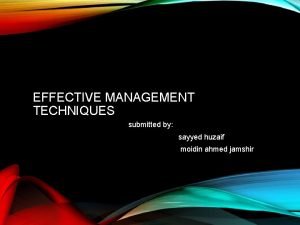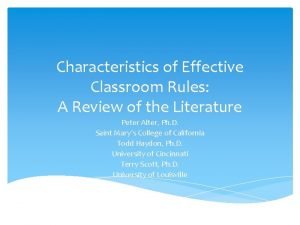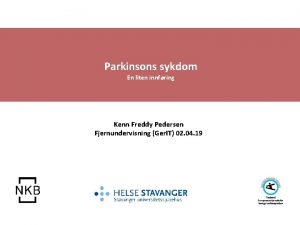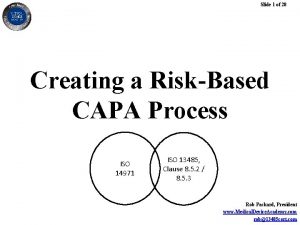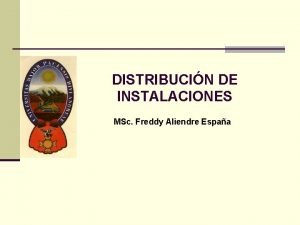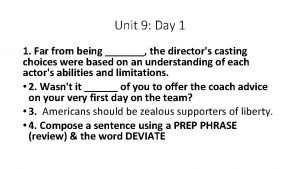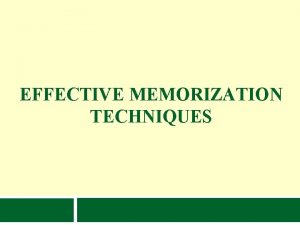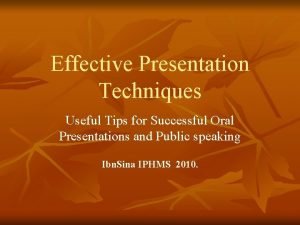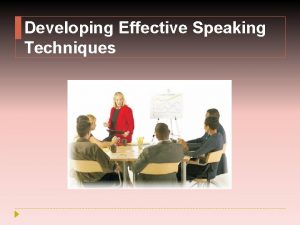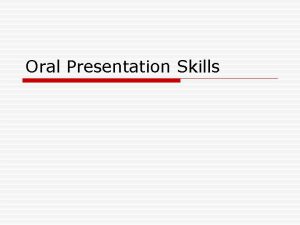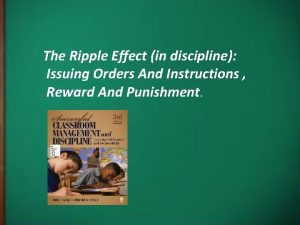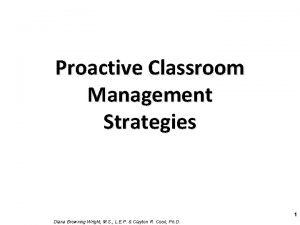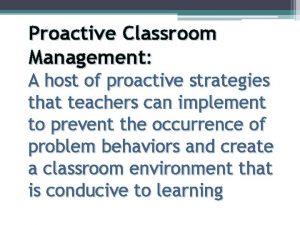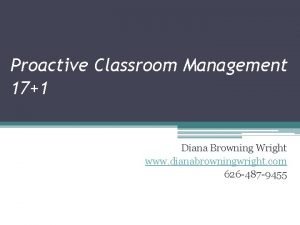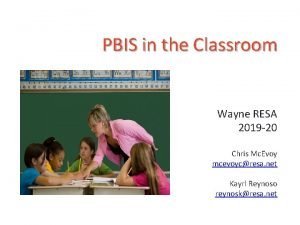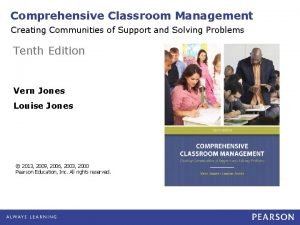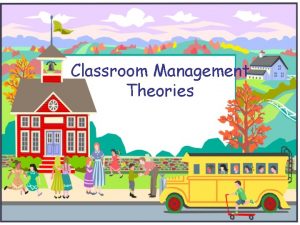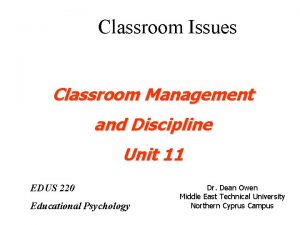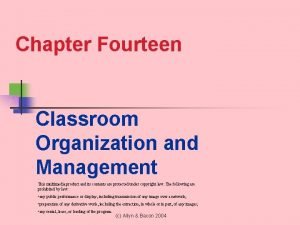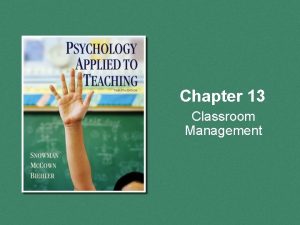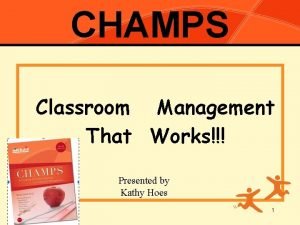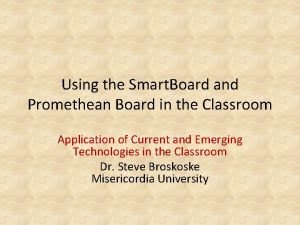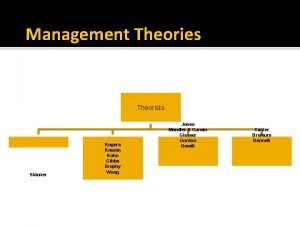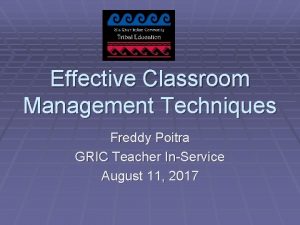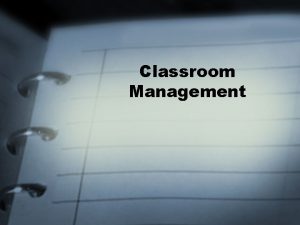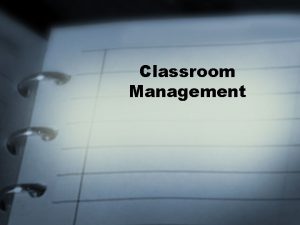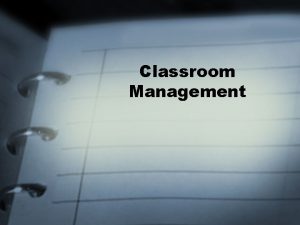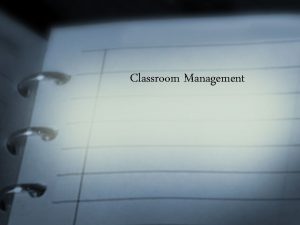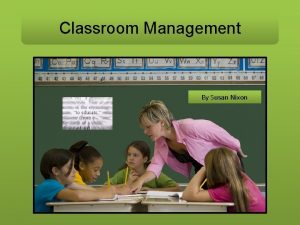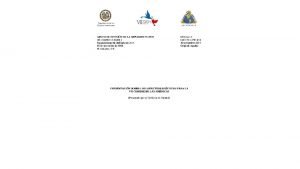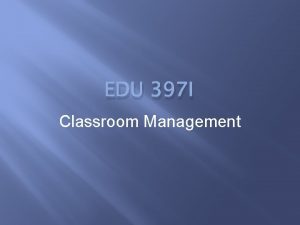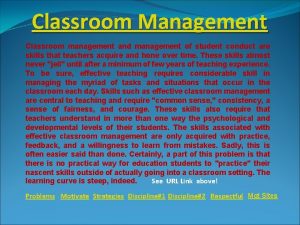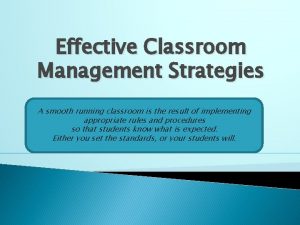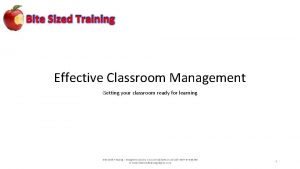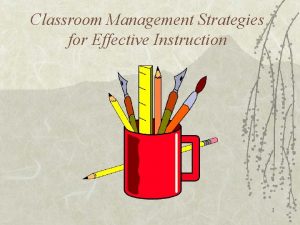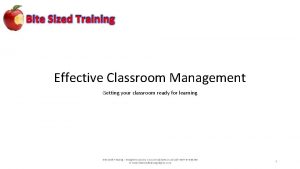Effective Classroom Management Techniques Freddy Poitra GRIC Teacher

























































- Slides: 57

Effective Classroom Management Techniques Freddy Poitra GRIC Teacher In-Service August 11, 2017

Beginning-of-Year Stress § On the next slide, look at both dolphins jumping out of the water. The dolphins are identical. A closely monitored, scientific study of a group of scientists revealed that in spite of the fact that the dolphins are identical, a person under stress would find differences in the two dolphins. The number of differences observed matches closely to the amount of stress the observer is experiencing. Look at the photograph and if you find more than one or two differences, you may be experiencing beginning-ofthe-year stress.


Topics for today include: § Harry Wong’s First Days of School --Having classroom management using procedures and routines (Unit C) § Teaching with Love and Logic --Some basic techniques that can be added to your toolbox § School Wide Procedures --How to Quiet a classroom and “The Signal System”

§ Some of today’s topics will be well-known for some and new (ah-ha moments) for others. Hopefully you can take away something new and know that there is one person who will make the difference in the success of your classroom this year…. . YOU!! § Try to be reflective during the presentation.

FYI § A study reviewing student learning looked at 11, 000 pieces of research that spanned over 50 years. It determined and ranked 28 factors that influence student learning. The most important factor is…. Classroom Management

Harry Wong Says: § The vast majority of the behavior problems in the classroom are caused by the failure of students to follow procedures and routines, which in turn are caused by teachers who do not have established procedures and routines. § Effective teachers MANAGE their classrooms with procedures and routines. § Ineffective teachers DISCIPLINE their classrooms with threats and punishments.

What is Classroom Management? ? § Everything a teacher does to organize students, space, time, and materials so that instruction and student learning can take place. § If Pilots have flight plans, Coaches have game plans, Executives have business plans, then Effective teachers must have a Classroom Management Action Plan. Do you?

4 Characteristics of a Well. Managed Classroom Characteristics Ineffective Teacher Effective Teacher 1. High Level of student involvement Teacher is working. Students are working. 2. Clear Student Expectations Teacher says “Know everything in Chapter 3. ” Teacher tells students objective of lessons and tests. 3. Little Wasted Time, Confusion, of Disruption Teacher punishes according to mood. Students always ask what the assignment is. Teacher has discipline plan and posts assignments. 4. Work-Oriented Teacher tells but does not practice procedures. Teacher yells and flicks light switch. Teacher practices procedures until they become routines and knows how to bring class to attention.

Seven things students want to know on the first day. § Am I in the right room? § Where am I supposed to sit? § Who is the teacher as a person? § Will the teacher treat me as a human being? § What are the rules in this classroom? § What will I be doing this year? § How will I be graded?

Don’t Forget that Smile § Stand at the classroom door on the first day with a big smile and a warm welcome. Ensure the students are in the right place. § Direct the students where to sit. § Have their first assignment (non-graded) ready and have them get started on it immediately. § Show that you are efficient and competent as a classroom manager and teacher. (First Impression)

The three most important student behaviors that must be taught the first day of school are these: § 1. Classroom Expectations—Have a plan § 2. Procedures § 3. Routines

Discipline vs. Procedures § § § Discipline concerns how students behave. Procedures concern how things are done. Discipline has penalties and rewards. Procedures have no penalties or rewards. ROUTINE: What the students do automatically. (habit) § Students readily accept a uniform set of classroom procedures because it simplifies their task in succeeding in school. It creates a predictable and consistent environment.

Basically…. . § Procedures are a part of our everyday lives—telephone book, airplanes, traffic lights, texting. § Teaching procedures is teaching expectations. § Story of “The Power of Procedures Success”

Classroom procedures that MUST become Routines 1. 2. 3. 4. 5. Beginning a class Quieting a Class Student seeking help Movement of students and papers End of Class

The Procedure for Teaching Procedures § Explain. State, explain, model, and demonstrate the procedure. § Rehearse and practice the procedure under your supervision. (Must DO!) § Reinforce. Reteach, rehearse, practice, and reinforce the procedure until it becomes a student habit or routine. Give Praise.

How to Quiet a Class 1. Explain that you will raise your hand 2. 3. or tap a bell and the students are to freeze, turn and face teacher, be ready for instruction. Model for the students. Rehearse the procedure by having the students visit quietly for a few minutes. Then raise your hand or tap a bell. Reinforce the procedure by correcting any mistakes or giving praise for following procedure. Then rehearse again and again.

How to Start the Day § Post a list of necessary morning routines such as: (verbally practice for lower grades) 1. Put coat and backpack in locker, come into the room, turn in homework, sharpen pencils, begin morning work. § Remember to explain, rehearse, reinforce. § Remember to post your assignments everyday in the same place. Also post your daily schedule.

Signal System § § § The “ineffective” way goes like this…… The “New Effective” way goes like this… 2 Fingers—Sharpen Pencil 3 Fingers—Get Drink/Use Bathroom 4 Fingers—Talk to Teacher 5 Fingers—Need Help


Movement of Paper § The “ineffective” way…. . § The “New Effective” Way 1. Pass across (sideways) putting papers on desks. Never put in hands.

Procedures to Rehearse (p 193) § § § § § Entering the classroom Listening and answering discussion questions Keeping a neat desk Asking questions for understanding Knowing the schedule When you are tardy or absent Turning in papers Heading a paper Coming to attention Walking in the halls Emergency Procedures If your pencil breaks Saying Please and Thank You When you finish early When visitors are in the classroom When a schoolwide announcement is made If you become sick Riding the Bus Going to Lunch Using the Bathroom— 1 at a time

“The Book” § Rather than writing names on the board, write them down in a book. This helps with documentation, if needed. It is amazing how quickly the class quiets down when they see you writing in “The Book. ”

Help Keep the Noise Down § Play music at a low level and the students must keep the noise level lower than the music. It works. § “Do you have a question” to talking students

When should you take roll?

If not, how much time is wasted? § 3 minutes per day X 180 Days =

A 92 Percent Homework Turn-in Rate § You’ve Been Pink-Slipped! § Students are not allowed to sit passively and not turn in their homework. They are required to take responsibility for their actions by completing a pink slip when homework is not turned in. The students will be warned of this procedure on the first day of school.

§ Provides excellent documentation for parent teacher conferences § No penalties, just lose credit for homework § Too many, lose privileges? ?


Attendance Keeper § Assign a student as the attendance keeper for the week § When the day begins, student puts ‘absent folder’ on desks of absent students § A quick glance will let you know who is absent when roll is taken (after students are working) § Fill absent folder as the day progresses with assignments missed and assignment sheet


A First Day of School Script § Football coaches go into a game with a script of their first 15 to 20 plays. Meeting and wedding coordinators have a script of what needs to be done. And effective teachers have a script that helps them to organize the first day or days of school. Now its time to write yours.


How to Take a Break Procedure § “In 15 minutes please be back in your seat —not walking in in or standing at the door. Please be in your seat in 15 minutes. When I raise my hand I would like it quiet so that I can immediately begin on ‘How to Use Love and Logic’ in your classroom. May I see a show of hands of anyone who does not understand the procedure? ”

Teaching with Love and Logic Founders--Jim Fay Foster Cline, M. D. Charles Fay, Ph. D.

Philosophy of Love and Logic § Choice and freedom to make mistakes. § Equal balance of consequences and empathy replace punishment whenever possible. § Child takes responsibility of his/her actions. § Student is required to do more thinking than the adult. § Child is always left with a feeling that he or she has some control.

§ Know that Love and Logic doesn’t replace your present system, instead it is a guide to help you solve the vast array of problems you may face in the classroom. It is a tool you can use to enhance your classroom management.

Why Does It Work? § Uses humor, hope, and empathy to build up the adult/child relationship § Emphasizes respect and dignity for both children and adults § Provides real limits in a loving way § Teaches consequences and healthy decision-making

The Three Rules of Love & Logic § Use enforceable limits--Don’t tell kids how to run their lives, instead tell them how you are going to run yours. § Provide choices within limits--Offer choices to students that you can deal with. § Apply consequences with empathy-- When consequences are applied with empathy the child has an opportunity to build a thought process about the mistake.

Control the time you spend on discipline by: § Building positive relationships with your students § Set enforceable limits through enforceable statements. § Share control. § Implement disciplinary interventions that stop undesirable behaviors in their infancy, avoiding the need for consequences. § Delay consequences.

Would you like to know what to say when kids try to push your buttons? § Use a one-liner: “Probably So” (stated softly) § I’m trying to engage you in an argument and here’s my ammunition: (No matter what I say – you say “probably so”. ) § Mrs. Morin doesn’t make me do this You’re mean I’m telling my Dad I’m telling my Mom I’m telling my Grandma I hate this This is stupid This sucks

Try It § I am the student and you just told me that if I don’t turn in my work I can’t go outside for recess. § So I say: That’s stupid. You’re mean. Other kids just get to go because their teachers are nice. I hate you. This sucks. I’m telling my Mom. You don’t like me.

§ “You don’t like me…Probably So” doesn’t sound right. Try this instead: § 1. Smile 2. Say: “Nice Try” § Other One-Liners: I respect you to much to argue; I know; Thanks for sharing; I bet it feels that way; I’ll listen to you as soon as your voice is as calm is mine. (Then walk away)

For Kids that have damaged selfesteems. § Try a One-Sentence Intervention 1. Think of a student that has low-self esteem or one that is hard to reach 2. In private, tell them something non-academic that you notice about them. 3. “I noticed that you worked hard during math today. ” Let the student respond, if at all. Then end with “I noticed that. ” 4. This is called “making a deposit” for when you may need to “make a withdrawal” (consequence). Give 1 per week until rapport has been established.

Using Choices § Be sure to pick choices you can live with § If child does not choose, be prepared to choose yourself (10 seconds). This teachers them to choose quickly. § Never give a choice unless you are willing to allow the child to experience the consequence of that choice.

Examples § Would you rather listen without interrupting or § § choose another place to be right now? You’re welcome to wear your coat or carry it with you. Do you want to sit in the red chair or the blue chair? Would you rather do questions 1 -5 or 6 -10? Out of the 40 problems, do the 20 easiest, I don’t care which ones you do.

CAUTION It is very easy to turn your choices into threats: Choose my way or the highway. Knock that off or I’m going to call your parents. Consider if your Principal said: Would you rather do your report today or get fired?

Empathy (not sympathy) § Adults must demonstrate a sincere and § § empathetic response to child’s misbehavior. We hand over the problem to the child solve. The students are in the thinking mode rather than the fighting mode. The child’s poor decision becomes the “bad guy” while keeping the adult the “good guy, ” thus having a hard time blaming the adult. You become a consultant, not the one who rescues.

Empathy One-Liners § § § § § This must really hurt. That is really hard I am sorry you feel that way. I feel bad for you. Bummer It must be hard to feel so frustrated. How Sad. Oh, man. What a drag. What will your one-liner be? Pick one or make up your own.

Power Messages After Empathy § What are you going to do about it? § Have you come up with anything so far? § I am here to help. Just let me know what you decide to do about it.

Let empathy and consequences do the teaching § NOT sarcastic or condescending § Keep it short, sweet and repetitive. § Express your empathy before your consequence § Delaying your consequence gives you time to think. Say “How Sad. I am going to have to do something about this! But now, I am teaching. I will later. Try not to worry about it too much. ” § This gives you time to think about your consequence and keep your cool.

Setting Limits with Enforceable Statements § The happiest students are those with teachers who set reasonable limits. § The happiest teachers are those who know how to set AND enforce these limits without raising their voices. § When you say “you will…” we lose control, but when you say “I will…’ we gain control. § An enforceable statement is something that YOU do, not the student. (can’t argue)

A few examples (see handout) § “You are not going to talk to me that way!” vs. “I will be glad to discuss this with you as soon as the arguing stops. ” § “You need to start respecting me. ” vs. “I will be happy to do nice things for you as soon as I feel respected and helped. ” § “There is too much talking” vs. “I take quiet classes to music. ”

Enforceable Statements and questions § Statement: I call on students who raise their hands. § Question: Who do I call on?

5 Steps for Guiding Students to Solve their own Problems 1. Provide a strong dose of empathy—Use 2. 3. 4. 5. your one-liner. Hand the problem back by ask “What are you going to do about it? ” Offer a menu of suggestions with “Would you like to know what some other students have done? ” Ask “How will that work for you” after each suggestion. Say “Let me know how it works out. Good Luck. ”

Resources § www. effectiveteaching. com (‘going beyond’ tab) § www. teachers. net (‘Harry Wong’ tab) Check out the archived articles § www. loveandlogic. com § “First Days of School” § Fay, J. & Funk, D. Teaching with Love and Logic. The Love and Logic Press Inc.

Questions?
 Modelo de gestión municipal
Modelo de gestión municipal Gric i grec
Gric i grec Colt gric
Colt gric Elements of effective classroom management
Elements of effective classroom management Effective management techniques
Effective management techniques Btech smart classes
Btech smart classes Characteristics of effective classroom rules
Characteristics of effective classroom rules Katherine poirier
Katherine poirier Kusttram storm
Kusttram storm Jahja santoso
Jahja santoso Storm freddy
Storm freddy Freddy druif
Freddy druif Freddy wittwer
Freddy wittwer Freddy the thirteen
Freddy the thirteen Luc dezeure
Luc dezeure Freddy pedersen
Freddy pedersen Freddy krieger
Freddy krieger מבחן באנגלית לכיתה ד freddy's world
מבחן באנגלית לכיתה ד freddy's world Refeeding syndrome electrolyte abnormalities
Refeeding syndrome electrolyte abnormalities Freddy bremaud
Freddy bremaud Prepare and serve cocktails
Prepare and serve cocktails Freddy porps
Freddy porps Freddy dezeure
Freddy dezeure Freddy aliendre
Freddy aliendre The teacher decided to a corner of the classroom
The teacher decided to a corner of the classroom Constructivism communication theory
Constructivism communication theory Difference
Difference Questioning and discussion techniques
Questioning and discussion techniques Effective memorization techniques
Effective memorization techniques Effective presentation techniques
Effective presentation techniques Evangelist morgan dead
Evangelist morgan dead Entertainment speech
Entertainment speech Effective oral presentation techniques
Effective oral presentation techniques Effective oral presentation techniques
Effective oral presentation techniques Effective oral presentation techniques
Effective oral presentation techniques Characteristics of effective selection techniques
Characteristics of effective selection techniques Unadjusted top-down selection
Unadjusted top-down selection Erf meaning
Erf meaning Good afternoon teacher my name is
Good afternoon teacher my name is Fonctions et solutions techniques
Fonctions et solutions techniques Jacob kounin ripple effect
Jacob kounin ripple effect Diana browning wright
Diana browning wright 17 proactive classroom management strategies
17 proactive classroom management strategies Diana browning
Diana browning Pbis classroom management checklist
Pbis classroom management checklist Learning and development plan for teachers
Learning and development plan for teachers What is overlapping in classroom management
What is overlapping in classroom management Jacob s kounin
Jacob s kounin Comprehensive classroom management
Comprehensive classroom management Ginott model
Ginott model Rote discipline meaning
Rote discipline meaning Dimension of classroom management
Dimension of classroom management Permissive classroom management
Permissive classroom management Champs classroom
Champs classroom Promethean vs smart board
Promethean vs smart board Jones theory of classroom management
Jones theory of classroom management Netop vision 7
Netop vision 7 Dreikurs classroom management theory
Dreikurs classroom management theory




